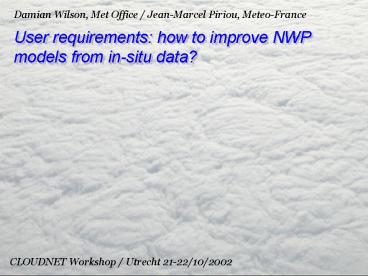Formation - PowerPoint PPT Presentation
1 / 11
Title:
Formation
Description:
CLOUDNET Workshop / Utrecht 21-22/10/2002. Damian Wilson, Met Office / Jean ... scale', Fran oise Guichard and al., submitted to MWR, revised version July 2002 ... – PowerPoint PPT presentation
Number of Views:22
Avg rating:3.0/5.0
Title: Formation
1
Damian Wilson, Met Office / Jean-Marcel Piriou,
Meteo-France
User requirements how to improve NWP models from
in-situ data?
CLOUDNET Workshop / Utrecht 21-22/10/2002
2
Model temporal integration
- Model prediction errors are to be found
- in the parameterizations (radiative
simplifications of the RTE) - in estimating sub-grid scale variability (e.g
link between ltqlgt and ltdgt ? ltqlqlgt) - in the prognostic variables from current time
step (cum. errors or analysis errors)
3
CLOUDNET useful for modellers to provide
- RS, radar, lidar, ? variables u, v, T, qv, ql,
qi, cloudiness, - Sub-grid scale variability, correlations of these
at ? space and time resolutions - Fluxes radiation, precipitation,
4
What has already been done in other projects to
compare models to in-situ data a recent example
Evaluating mesoscale model predictions of clouds
and radiation with SGP ARM data over a seasonal
time scale, Françoise Guichard and al.,
submitted to MWR, revised version July 2002
5
(No Transcript)
6
(No Transcript)
7
(No Transcript)
8
(No Transcript)
9
(No Transcript)
10
(No Transcript)
11
Comparison model versus observations
- Difference between model and observations come
from - Model errors
- Observational errors
- Transform errors
- To have an idea whether a difference is a model
error we need - To assess observational and transform errors
- To compare model-observations from the different
sites - To compare model-observations from the different
models and to relate their differences to model
formulations - ? Importance of having the same set of
well-defined variables AND the same file formats - Comparisons may be handled (i) qualitatively (ii)
quantitatively (transforms)

